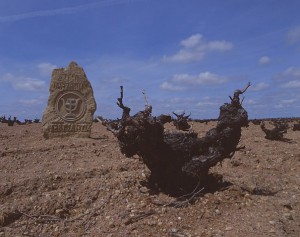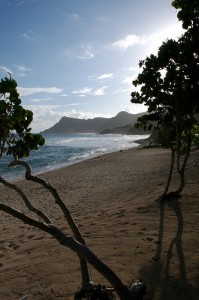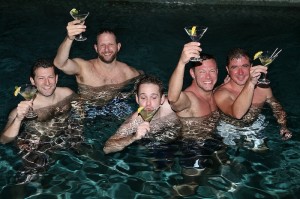 For years, several of my friends from the Los Angeles area have been enamored with the wines of Santa Barbara. They’ve allowed me to sample their stash, but many of these wineries are smaller production, so the wines don’t always make it out of California. Recently, my husband and I decided to do a quick jaunt to Santa Barbara wine country to delve a little further into what this region has to offer.
For years, several of my friends from the Los Angeles area have been enamored with the wines of Santa Barbara. They’ve allowed me to sample their stash, but many of these wineries are smaller production, so the wines don’t always make it out of California. Recently, my husband and I decided to do a quick jaunt to Santa Barbara wine country to delve a little further into what this region has to offer.
Quick Primer on Santa Barbara County Wine Country:
Santa Barbara County experiences warm days and very cool nights, along with fog and breezes from the Pacific Ocean. There are five distinct wine regions within the county:
- Santa Maria Valley AVA (American Viticultural Area) – As the northernmost region of Santa Barbara County, it enjoys extremely complex soil conditions and diverse mesoclimates, allowing for Chardonnay and Pinot Noir to thrive. Santa Maria Valley was the first officially approved AVA in Santa Barbara County.
- Santa Ynez Valley AVA – This AVA has very cool temperatures, becoming warmer toward the eastern parts of the region. Therefore, varietals vary from the fog and cool loving Pinot Noir in the west to Cabernet Sauvignon and Merlot, which flourishes in the warmer temperatures in the east. Some Italian and Rhône varietals also prosper in this AVA.
- Sta. Rita Hills AVA – This is a relatively small appellation of approximately 100 square miles located within the western corridor of the larger Santa Ynez AVA. The ocean fogs usually burn off by mid-morning, with a few hours of sunshine, followed by winds. The influence from the Pacific along with the sedimentary soils found in Sta. Rita also creates an ideal location for Chardonnay and Pinot Noir.
- Los Alamos Valley – This region experiences warm days and cool nights. Wines from this area will be indicated on the label as “Santa Barbara County.”
- Happy Canyon of Santa Barbara – The varied soils and terrain of this region are best suited for growing Bordeaux varietals such as Cabernet Franc, Cabernet Sauvignon, Merlot, Petit Verdot and Sauvignon Blanc; however, Syrah and other Rhône varieties also do well in this region.
Maybe I wasn’t accustomed to having a burn on my palate when I tasted Pinot Noir, but of the wines we tasted, I found many to be a little too high in alcohol (15%+). Generally speaking, I tended to favor the Chardonnay from this region over the Pinot Noir (although I did enjoy some really lovely Pinots). Unfortunately, given our time parameters, we weren’t able to make it to all of the wineries on my “to do” list, but of those that we were able to visit, there were three that stood out. I have listed my favorites below.
2935 Grand Avenue #B (tasting room)
Los Olivos, CA
805-688-0305
During his student days at Berkeley, Rick (Richard) Longoria experienced the wines of Sonoma and Napa. “Not knowing anything about the business… Rick decided to take a year off before entering law school, and traveled to South America…. It was during this trip that he came to realize that his heart was not in law, but rather [with] the possibility of working in a winery. When he returned, he sent dozens of inquiries to wineries looking for work. He got lucky and was hired as a rookie cellar man at one of his favorite wineries…” Rick shared with me that over the years, he continued to work on his craft of wine making, and in 1982, they [he and his wife] “started the brand as a part time endeavor. Then, we both gave up our day jobs to focus on making the business our sole source of income.” Longoria was born and they haven’t looked back.
Longoria excels among their peers. These wines exhibit elegance, finesse and a balanced degree of minerality. When savoring their wines, you will personally experience their quest for excellence. Rick disclosed to me, “My philosophy of winemaking is based on my belief that wine is a food, and as such, its greatest role is to accompany meals. Wines should therefore be made in a way that respects the uniqueness of each grape varietal, each vineyard site and the vagaries of each vintage. They should also be made to be well balanced so that the wine does not overpower the food. When one of my wines is paired with a meal and the food and the wine are both made more interesting and enjoyable as a result, then I have succeeded as a winemaker.”
The winery averages just about 3500 cases annually. The vineyards are located in Sta. Rita Hills and their wines are a must try on your visit to Santa Barbara.
Chardonnay Cuvée Diana
from Sanford & Benedict Vineyard, the oldest vineyard in Sta. Rita Hills and Rancho Santa Rosa
- 2007 (ST 90, $36): fresh peaches, honey and smoky minerals with a nice balance of richness and acidity
- 2008 (WE 94, $36): pears with maple syrup and nutmeg, honeysuckle, balanced acidity and weight, honeysuckle
2008 Pinot Noir Rancho Santa Rosa ($45): black and red berries with a hint of brett and vanilla; nice weight with silky tannins; one which seemed to fly under the radar, but one to watch
2007 Fe Ciega Vineyard (ST 91, WE 93, $54): cigar and sage spices; smooth but intense tannins; strong acidity
7200 Foxen Canyon Road
Santa Maria, CA
805-937-4251
When I polled my friends who had lived or are currently living in the Los Angeles area as to their Santa Barbara wine country faves, Foxen was at the top of each list, time and time again, as was Foxen’s rustic, but very endearing tasting room. Foxen recently added on a new, state-of-the-art, solar paneled tasting room, which is where I tasted their wines on my visit. I was a little bummed as I had been looking forward to experiencing their former tasting room, which had been lovingly described to me as “rustic as hell and looking more like a place you go to get pumpkins in October than a tasting room.”
Winemakers Bill Wathen and Dick Doré, otherwise known as the “Foxen Boys” like to say, “if you don’t know FOXEN, you don’t know Dick . . . or Bill.”
Bill’s background includes a degree in Fruit Science, specializing in vineyard management from Cal Poly University. In 1978, he became “a vineyard manager at Chalone Vineyard, where he was mentored by California wine pioneer and Chalone founder, Dick Graff. It was here that Bill learned traditional French winemaking techniques and appreciation for great Burgundies. Graff’s influence inspires Bill’s winemaking philosophy to this day.”
A man after my own heart, Richard, having “worked as a banker in the late sixties and seventies, quit his nine-to-five job and moved his family to Europe… Over the next year and a half, Dick traveled the back roads of France, Italy and Spain, where he developed his love of wine.” Dick eventually returned to his native Santa Barbara County, where he crossed paths with Bill and forged a partnership in making wine together. Dick’s wife, Jenny, is involved in the business as well, running marketing efforts in California and Florida.
 2008 Chardonnay Bien Nacido Vineyard UU (WS 91, $32): tangy citrus, grapefruit and green apples with some floral aromas
2008 Chardonnay Bien Nacido Vineyard UU (WS 91, $32): tangy citrus, grapefruit and green apples with some floral aromas
2008 Pinot Noir Bien Nacido Vineyard-Block N ($52): blackberries and wild berries with some spice
5175 East Highway 246
Lompac, CA
805-736-1455
In 1978, Walt and Mona Babcock sought “retreat from Walt’s dental practice and the rigors of being restaurateurs… Their search led them to purchase 110 acres of land on the western edge of the Santa Ynez Valley in Santa Barbara County, [which] at that time the area was considered a fledgling wine region. This inspired and prompted the Babcocks to plant a 25-acre vineyard in 1980. By the end of 1983, various notable winemakers had purchased Babcock fruit and made compelling wines… In 1984, Walt and Mona Babcock decided it was time to seize the opportunity to produce their own wine.” Armed with a degree in biology and a minor in chemistry from Occidental College, and working toward his master’s degree in food science, with an emphasis in oenology at UC Davis, their son Bryan entered the picture and has been making Babcock’s wine since 1984.
I was pleasantly surprised by their $30 Grand Cuvée, which we had with one of our meals.
 2008 Grand Cuvée ($30) crème brulée, pineapple, pear, with balanced richness and some acidity
2008 Grand Cuvée ($30) crème brulée, pineapple, pear, with balanced richness and some acidity
5185 East Highway 246
Lompoc, CA
805-735-7030
Sad to say, I wasn’t able to make it to Melville this time around. However, it came very highly recommended by many, so I thought I should include this winery in the article. Perhaps next time?
Visiting Santa Barbara and short on time?
Many of the wineries of this region are too small or too removed to have their own tasting rooms, so they opt for presence in the town of Los Olivios. It is a charming, quaint little town. Jokingly, my friend Karl stated the proximity of so many tasting rooms in Los Olivios enables people “do their own pub crawl.” It depends on what your shtick is, but if you are staying in town, it is an elegant solution to sampling wines of the region without the rock-paper-scissors exercise to see who gets the driving responsibilities.
2879 Grand Avenue
Los Olivos, CA 93441
805-688-7265
Not only does this place have a decent selection of wines, but the cafe is also a pleasant place to have lunch.
Note: For planning your wine trip to Santa Barbara County, this particular website was very useful: Santa Barbara County Vintners’ Association
A Burger in Santa Monica… I digress

While this article highlights some of the wines of Santa Barbara County, I feel it imperative to share this little nugget. If you happen to be in LA area, don’t miss having a burger at Father’s Office. As you can see from the photo, we hit their Santa Monica location after watching the sunset on the beach with a lovely glass of wine from Foxen.
1018 Montana Avenue
Santa Monica, CA
310-736-2224
Run, don’t walk. This possibly one of the best three burgers in my life. My husband says it is his top burger…caramelized onion, bacon, Gruyère, Maytag blue cheese and arugula.
 One of my dearest friends lives in San Francisco (yes… it would be the legendary Premila), so I am fortunate to visit the city regularly. Since San Francisco has the luxury of a vast supply of fresh and locally produced and sourced food and wine, the tasty possibilities are infinite. You kind of can’t go wrong here. That being said, I do have my go-tos and am asked frequently to list them. Et voila:
One of my dearest friends lives in San Francisco (yes… it would be the legendary Premila), so I am fortunate to visit the city regularly. Since San Francisco has the luxury of a vast supply of fresh and locally produced and sourced food and wine, the tasty possibilities are infinite. You kind of can’t go wrong here. That being said, I do have my go-tos and am asked frequently to list them. Et voila: Only week two into our London adventure and still sleeping on our air mattress, we received an email from our friend Seb asking us if we’d like to participate in a dinner club for oenophiles that his friend Guillaume organizes. Serendipitous, right?
Only week two into our London adventure and still sleeping on our air mattress, we received an email from our friend Seb asking us if we’d like to participate in a dinner club for oenophiles that his friend Guillaume organizes. Serendipitous, right? Foie gras, port reduction and parmesan foam
Foie gras, port reduction and parmesan foam For years, several of my friends from the Los Angeles area have been enamored with the wines of Santa Barbara. They’ve allowed me to sample their stash, but many of these wineries are smaller production, so the wines don’t always make it out of California. Recently, my husband and I decided to do a quick jaunt to Santa Barbara wine country to delve a little further into what this region has to offer.
For years, several of my friends from the Los Angeles area have been enamored with the wines of Santa Barbara. They’ve allowed me to sample their stash, but many of these wineries are smaller production, so the wines don’t always make it out of California. Recently, my husband and I decided to do a quick jaunt to Santa Barbara wine country to delve a little further into what this region has to offer.



 Why do people do what they do – both personally and professionally? I’ve always had a mild fascination with this topic.
Why do people do what they do – both personally and professionally? I’ve always had a mild fascination with this topic.


 It’s a rainy Monday morning. In lieu of the grind, would you fancy taking a virtual whirlwind visit to the wine region of Toro, Spain, along with sampling slivers of melt-in-your-mouth Pata Negra, Spanish cheese, and then, topping off your experience with some of your favorite champers? Um, hello, happy Monday to me…
It’s a rainy Monday morning. In lieu of the grind, would you fancy taking a virtual whirlwind visit to the wine region of Toro, Spain, along with sampling slivers of melt-in-your-mouth Pata Negra, Spanish cheese, and then, topping off your experience with some of your favorite champers? Um, hello, happy Monday to me…


 +590 590 297 999
+590 590 297 999 My sister-in-law and her boyfriend were smart enough to ask for the recipe before we left. (Merci bien Marion et Lio.) This particular cocktail always makes our family smile. We hope it has the same effect on you. Note: The glasses featured in this photo aren’t the ones we use for Le Sereno Mojito. We opt for a tall glass, but I can assure you that those featured in this photo from our après mariage soirée did have one or TWO Sereno Mojitos.
My sister-in-law and her boyfriend were smart enough to ask for the recipe before we left. (Merci bien Marion et Lio.) This particular cocktail always makes our family smile. We hope it has the same effect on you. Note: The glasses featured in this photo aren’t the ones we use for Le Sereno Mojito. We opt for a tall glass, but I can assure you that those featured in this photo from our après mariage soirée did have one or TWO Sereno Mojitos.